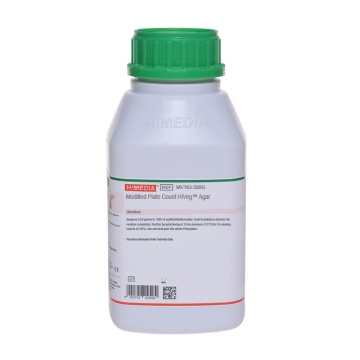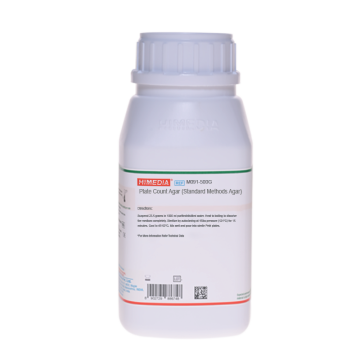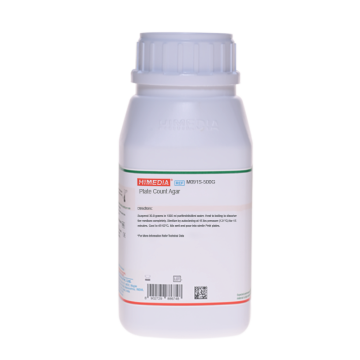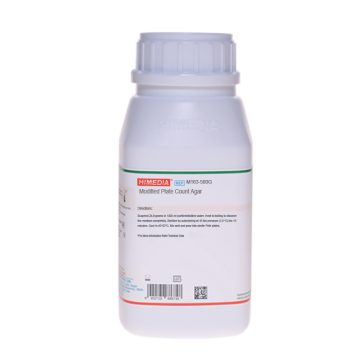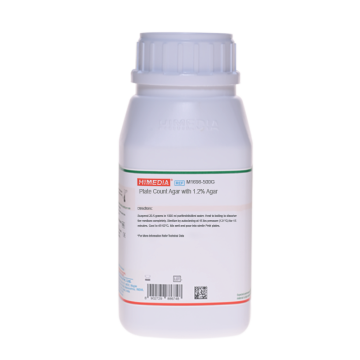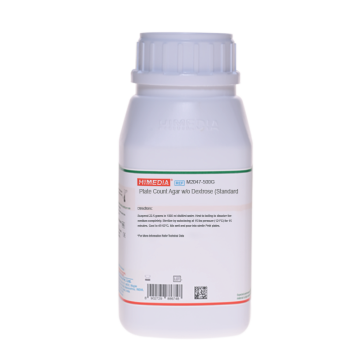 Your enquiry has been submitted
Your enquiry has been submitted
High Plate Count Agar
Total Plate Counts#CC293D
Intended Use:
Recommended for obtaining higher colony counts by spread plate or pour plate or membrane filtration technique.
Composition**
| Ingredients | Gms / Litre |
|---|---|
| Peptone | 3.000 |
| M-Protein soluble # | 0.500 |
| Dipotassium hydrogen phosphate | 0.200 |
| Magnesium sulphate | 0.050 |
| Iron (III) Chloride | 0.001 |
| Agar | 15.000 |
Final pH (at 25°C): 7.2±0.2
**Formula adjusted, standardized to suit performance parameters
# Equivalent for Casein soluble
Directions
Suspend 18.75 grams in 1000 ml purified/distilled water. Heat to boiling to dissolve the medium completely. Sterilize by autoclaving at 15 lbs pressure (121°C) for 15 minutes. Mix well and pour into sterile Petri plates.
Principle And Interpretation
The heterotrophic plate count (HPC), formerly known as the standard plate count is a procedure for estimating the numbers of live heterotrophic bacteria in water and measuring the changes during water treatment and distribution or in swimming pools. Different methods namely pour plate method, spread plate method and membrane filter method can be followed to obtain heterotrophic plate count. High Plate Count Agar is recommended by APHA for determining heterotrophic plate count (1). This low nutrient medium is likely to produce higher colony counts than high nutrient media.
Peptone and M-Protein soluble provide the necessary nitrogenous compounds for the growth of heterotrophic microorganisms. Metallic salts and dipotassium phosphate together with Peptone and M-Protein soluble promotes the growth of higher number of microorganisms. Refer appropriate references for standard procedures (1).
Type of specimen
Water samples
Specimen Collection and Handling
For water samples, follow appropriate techniques for sample collection, processing as per guidelines and local standards.(1)
After use, contaminated materials must be sterilized by autoclaving before discarding.
Warning and Precautions :
Read the label before opening the container. Wear protective gloves/protective clothing/eye protection/ face protection. Follow good microbiological lab practices while handling specimens and culture. Standard precautions as per established guidelines should be followed while handling specimens. Safety guidelines may be referred in individual safety data sheets.
Limitations :
- Individual organisms differ in their growth requirement and may show variable growth patterns on the medium
Performance and Evaluation
Performance of the medium is expected when used as per the direction on the label within the expiry period when stored at recommended temperature.
Quality Control
Appearance Cream to yellow homogeneous free flowing powder
Gelling Firm, comparable with 1.5% Agar gel
Colour and Clarity of prepared medium
Light yellow coloured, clear to slightly opalescent gel forms in Petri plates
Reaction
Reaction of 1.88% w/v aqueous solution at 25°C. pH: 7.2±0.2
pH
7.00-7.40
Cultural Response
Cultural characteristics observed after an incubation at 35-37°C for 18-24 hours.
| Organism | Inoculum (CFU) | Growth | Recovery |
|---|---|---|---|
| Bacillus subtilis subsp. spizizenii ATCC 6633 (00003*) | 50-100 | luxuriant | >=70% |
| Enterococcus faecalis ATCC 29212 (00087*) | 50-100 | luxuriant | >=70% |
| Escherichia coli ATCC 25922 (00013*) | 50-100 | luxuriant | >=70% |
| Lactobacillus casei ATCC 9595 | 50-100 | luxuriant | >=70% |
| Staphylococcus aureus subsp. aureus ATCC 25923 (00034*) | 50-100 | luxuriant | >=70% |
| Streptococcus pyogenes ATCC 19615 | 50-100 | luxuriant | >=70% |
Key: *Corresponding WDCM numbers.
Storage and Shelf Life
Store between 10-30°C in a tightly closed container and the prepared medium at 20-30°C. Use before expiry date on the label. On opening, product should be properly stored dry, after tightly capping the bottle in order to prevent lump formation due to the hygroscopic nature of the product. Improper storage of the product may lead to lump formation. Store in dry ventilated area protected from extremes of temperature and sources of ignition. Seal the container tightly after use. Product performance is best if used within stated expiry period.
Disposal
User must ensure safe disposal by autoclaving and/or incineration of used or unusable preparations of this product. Follow established laboratory procedures in disposing of infectious materials and material that comes into contact with sample must be decontaminated and disposed of in accordance with current laboratory techniques (2,3).
Reference
- Baird R.B., Eaton A.D., and Rice E.W., (Eds.), 2015, Standard Methods for the Examination of Water and Wastewater, 23rd ed., APHA, Washington, D.C.
- Isenberg, H.D. Clinical Microbiology Procedures Handbook 2nd Edition.
- Jorgensen, J.H., Pfaller, M.A., Carroll, K.C., Funke, G., Landry, M.L., Richter, S.S and Warnock., D.W. (2015) Manual of Clinical Microbiology, 11th Edition. Vol. 1.
| Product Name | High Plate Count Agar |
|---|---|
| SKU | M1097 |
| Product Type | Regular |
| Physical Form | Powder |
| Origin | Animal |
| Packaging type | HDPE |
| References | 1.Eaton A. D., Clesceri L. S., Rice E. W. and Greenberg A. W., (Eds.),2005, Standard Methods for the Examination of Waterand Wastewater, 21st Ed., APHA, Washington, D.C |
| Customized Product Available | No |




